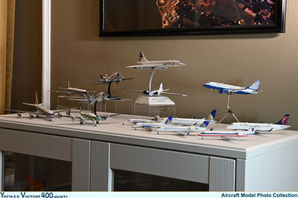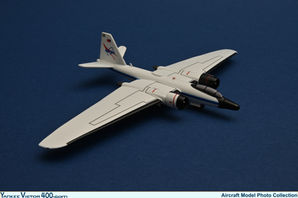The Best (and worst) 747-100/200s in 1:400 Scale
- Jorge A. Zajia
- Oct 1, 2023
- 7 min read
Updated: Oct 27, 2023
Even though the sun is finally setting for the 747, today it continues to be an icon of commercial air travel. A revolutionary aircraft with an enormous impact on society, and easily the one that has been replicated the most in the form of toys and scale models.
There are many 747 variants and sub-variants. Let's take a look at some of the most popular molds in 1:400 scale of the first version of the type, the early production -100 and -200, and see how they compare.
Molds
1) BigBird: First appearing in 2003 models made with this mold have been marketed as YourCrafstman400, BigBird, Witty Wings, Apollo, Aeroclassics (and their sub-brands), JC Wings, and who knows what else. Today the mold belongs to JC Wings, and they use it with some regularity. The majority of their recent releases, though coming in boxes whose design matches that of JC Wings', are being marketed as YourCraftsman400 (which is interchangeable with BigBird), giving a new life to the iconic brand name that seemed to be extinct. The mold has gone through some minor tweaking, and its current version is often referred to as BigBird Mark 3. However, it is still fundamentally the same mold that first appeared in 2003 plus antennas and modern printed details. In fact, when Aeroclassics uses the mold, which still happens once in a blue moon (some are buried in the pipeline as we speak), they don't add all the details of the Mk.3 version.
The mold is a favorite of many. Besides sporting a beautiful front section (though it might not be entirely accurate, as I will point out later), and a very decent body, a major contributor to its popularity is the fact that it has been used to produce an unmatched array of globally acclaimed classics.

2) GeminiJets: The original version of this mold dates to 1999, but it has been improved considerably. The mold is still active, in fact, a new Air Force One VC-25A just arrived at stores last week. However, its use has been extremely sporadic in recent times (only a release every several years). It is a very nice mold, and several gems have also been produced using it, such as the American Airlines example below. The most current version of the mold sports antenas on the fuselage, and modern tire hubs.

3) Dragon Wings: This mold is almost as old as the GeminiJets one and was also used extensively to produce models for Jet-X. It was never updated, and it's no longer in use as Dragon Wings left the business of 1:400 airliners during the early 2010s. The mold, however, is very good, to the point that it is considered the best rendition of the jumbo in 1:400 scale by a number of collectors. Its main weakness is the simplicity of its landing gear and other details. Dragon Wings 747s are very popular in the second-hand market and tend to hold their value well, with some being very sough-after, such as the Pan Am example below:

4) Aviation400: This mold is an improved version of the highly appraised BigBird tooling and was marketed under the Aviation400 banner, as well as InFlight400. The mold saw a relatively short career during the late 2000s and early 2010s. It is included in this article mainly for reference as it is considered the cream of the crop of the 747-100/200 molds in 1:400 scale, but it wasn't a major player. The mold retained the basic fuselage shape of the BigBird mold (as we will see later in this article), but the wing cradle piece was replaced with individual slot-in wings. The vertical fin and tail area were also refined.

5) Phoenix Models: In contrast with the other molds that have been mentioned thus far, this one doesn't have many fans. In spite of this, the mold has been particularly active in the 2021-2023 period, and many classic liveries are being released and re-released on it.

While I agree with the general opinion the 1:400 scale collecting community has on the molds discussed above, I think we tend to get carried away by popular opinions and lose sight of the fact that the molds we put on a pedestal are really not all that great, and the ones we trash are not all that awful.
The Real Deal
On September 19, 2012 Space Shuttle Endeavour visited Houston on its way to its final resting place at the California Science Center. The relevant part of that story to this article is that the Shuttle came piggybacking on top of N905NA, a modified 747-123, and I took a lot of photos of it. I will use those photos in this article to compare the 1:400 molds that I listed above with a real 747-100.
I am going to focus heavily on the nose section because it is the face of the airplane. While details pertaining to the rest of the airplane are also important, they can't make a model "good" if the front section is not up to standard. The opposite is not always true (the BigBird 747 can be considered a good example of this).


At a glance and from a distance the nose and cockpit section of that 747-123 look sleek, don't they? Pretty much just like the nose on the BigBird 747-121 below:

The BigBird 747 nose is indeed delightful. However, I don't think it is quite perfect, rather it is the idealistic 747 front section. In reality, the 747 front section is not as sleek and tidy, especially the cockpit. The 747 is the only Boeing jetliner built thus far in which the cockpit windshield does not coincide with the point where the flight deck ends and the nose cone begins (with the exception of the 787 which has no externally visible division between the cockpit and nose cone), as it is usually depicted on the BigBird mold.
In the pictures below you can see that there is actually a small portion of fuselage skin below the windshield before the nose cone begins, giving the 747 a rugged look.


The issue is that this is only evident when seen in profile, and from a relatively close distance. Angles, lighting, and the usual distances between airport terminal windows and aircraft tend to hide this feature.
Now that we have established how the 747 front section, particularly the cockpit windshield and forehead, should look, let's discuss the front sections of the molds included in this article.



In the photos above it is evident that GeminiJets and Dragon Wings placed the cockpit windshield accurately in the larger foreheads of their 747 molds. The forehead on the BigBird mold is too narrow, placing the cockpit windshield any higher will bring it too close to the roof (it has been done, as I will show later). It is difficult to decide which front section is better between Dragon Wings and GeminiJets, they are both great.
So, what about Phoenix?
There is no question that the Phoenix 747 nose cone is too blunt. However, where they place their cockpit windshield has a huge impact on the look of the model. Unfortunately, they have shown inconsistency in this area.
The picture below shows a Phoenix 747-200 with the cockpit windshield printed right at the joint between the cockpit and the nose cone area (too low), just like BigBird does. Keep in mind that the Phoenix 747-200 mold has a larger forehead than the BigBird mold (just like the Dragon Wings and GeminiJets molds do, as shown above):

And below is a photo showing a Phoenix 747-200 with the cockpit windows positioned more in line with the real aircraft.

The photos below are just to show that the BigBird. Mk.3 and the Aviation400 747-200 molds share the same nose with the original BigBird mold from the early 2000s. The particular KLM BigBird Mk.3 example I used seems to have a slightly improved forehead, but I think it is simply the result of inconsistencies in the production line.


As I mentioned, there have been attempts to print the cockpit windows a tad higher on the BigBird mold. Below you can see a 2014 Lufthansa example produced by Witty Wings/Apollo on the BigBird mold (Mk.2?). It does not look too bad, though certainly not as accurate as the GeminiJets and Dragon Wings examples shown earlier in this article, and the windshield does look squeezed in the narrow forehead of the mold. That does not prevent the magnificent lines of the BigBird nose cone from shining on this model:


Rest of the Airplane
And because there is more to the 747 than just the nose, here are some photos showing other parts of the airplane and the molds in question for you to make your own opinion of where things stand.












Considerations and Personal Thoughts
Engines: There are three basic engine types shown in this article. The engines on the British Airways models by Phoenix and InFlight400 (Aviation400) are the Rolls Royce RB211-524. The Alitalia (Baci c/s) and Lufthansa models, both on the BigBird mold, carry the General Electric CF6-50 engine. The rest of the models (Dragon Wings, GemininJets, Aeroclassics/BigBird), as well as the real aircraft (N905NA) all carry Pratt & Whitney JT9D engines.
I think between Phoenix and Aviation400, the latter wins when it comes to the RB211-524, as well as pylons (Phoenix's are chunky and unrefined). The CF6-50s look rather nice on the BigBird mold. In contrast, I think the BigBird JT9Ds are the worst of the bunch with Dragon Wings being the best.
Several pylons with curved/angled trailing edges can also be seen on the models in this article, but a quick Google investigation reveals that all of the models here should have been equipped with the early pylons with the straight trailing edge, such as those seen on the photos of N905NA, the real aircraft shown in this article. For more info on this subject see this thread at the Model Airliner Forum.
Vertical stabilizer: One of the main critics of the otherwise acclaimed BigBird mold is the tail. What I can see is that the vertical fin tapers a bit much, making it too narrow on the upper end when seen in profile. It is also poorly refined, and it does not fit well onto the fuselage. Almost every other 747 vertical fin in 1:400 looks better. The Phoenix effort is often criticized because only its front end is attached to the fuselage, leaving a visible gap running along the aft half of its root.
Other details: Refer to Yesterday's Airlines 747-100/200 molds in 1:400 scale review to get a look at other elements of these molds. I encourage you to make your own conclusions.
The Future
NG Models recently unveiled a series of new molds which included a 747-400 and a -200/100 mold. Many collectors were eagerly awaiting NG's 747-200 announcement
as the current molds, though good and upgraded, are getting old. Crucially, they have cradle-type wings, and manufacturers don't want to use them too liberally. The exception to all that is Phoenix, their mold is not old, has slot-in wings, and they do use it, but, while it gets the job done, it is not the best mold available.
Unfortunately, NG's announcement was bittersweet. While the mold does look promising, it also needs quite a bit of refinement before becoming acceptable. To become top-notch it needs a considerable redesign. You can find a comprehensive review of the NG 747-200 mold sample at Yesterday's Airlines.

Jorge A. Zajia

























